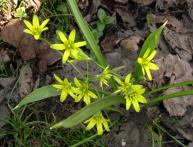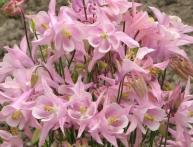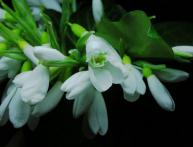Lily: care at home, how to prepare the bulb for planting
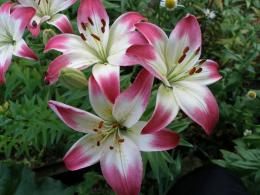
You can admire the blooming lilies not only in your garden, but also at home. This is a plant with bright greenery and large flowers, which delights with its abundant flowering for a long time.
Garden lilies can grow up to half a meter or more in height, and the compact plant can be grown in pots at home. How to achieve abundant flowering lilies at home?
Content:
- How to choose soil for planting
- Preparation for planting and growing conditions
- Care after landing
- Possible diseases and pests
How to choose soil for planting
Lilies are planted at home in early spring or autumn. Lily grows well in fertile soil with the addition of river sand. In order for the flower to grow strong and healthy, you need to properly prepare the substrate. The main components of the nutrient mixture: turf, leaf soil, humus, sand.
The ingredients should be taken in a ratio of 3:1:1:1. The substrate can be purchased at a specialized store, but it is better to prepare it yourself.
A prerequisite for good growth is drainage. Expanded clay, pebbles, brick chips, etc. can be used as a drainage layer. Drainage should be about 13 times the volume of the pot. The container for planting should be chosen to be small in size with a diameter of about 16-18 cm. If the container is wide, then several species of the same plant can be planted.
Preparation for planting and growing conditions
For landings Lilies should choose bulbs with a well-developed root system. In addition, you should carefully inspect the bulb for spots of rot. Before planting, the bulb should be placed in the refrigerator for 17-20 days. After this, treat with potassium permanganate: soak in the pink solution for about 1.5 hours. At the final stage, add a growth stimulator to the solution.
Planting a lily is carried out as follows: pour a drainage layer on the bottom of the pot, and then a nutrient substrate. Next, carefully place one onion in the middle of the pot and sprinkle it with 23 degrees of soil. You should not fill the container to the top with the substrate. As soon as the leaves appear, cover the exposed part of the bulb with the remaining soil.
Pots with lilies are best placed on the southeast or southwest side. It is recommended to place the container not on the windowsill, but on a stand near the window. Lily loves diffused sunlight.
The plant does well at average room temperature. Lily can tolerate both heat and slight drops in temperature, but not frost. When green sprouts appear, you can move the pot to the windowsill and balcony.
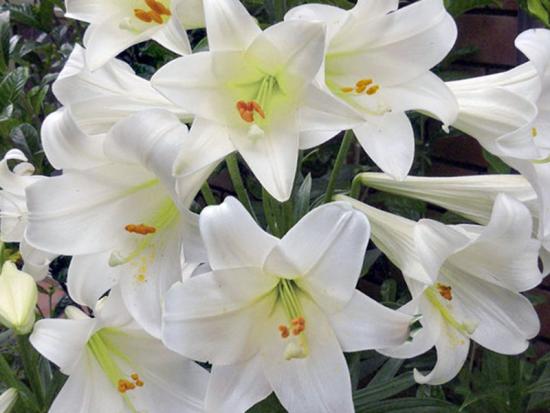
In hot weather, cultivation continues in a cool place and fresh air must be provided. In winter, life processes slow down, so the plant requires rest. The lily should be placed away from heat with an optimal temperature of +5 degrees.
Care after landing
Care After planting, caring for a lily includes regular feeding, watering, loosening, and spraying. During the period of intensive growth of the lily, the necessary amount of moisture and good nutrition should be provided.
When choosing fertilizers, it is recommended to use those designed specifically for bulbous plants. Beginning flower growers should know that during the period of active growth, the lily should be fed with nitrogen fertilizer, and after the first flowers appear - with potassium-phosphorus fertilizer.
With the onset of warm spring weather, you can feed with slurry, previously diluted in water in a ratio of 1:10, but no more than once within three months.
The first feeding is applied during the flower growth period, the second during the formation of buds, and the third after flowering. It is recommended to periodically add wood ash to the soil. Before flowering, young lilies should be sprayed with cool water in which a growth stimulator should be diluted.
Video about planting and growing lilies in the garden:
This procedure will greatly facilitate the establishment and flowering of the plant. It is recommended to spray the ground parts with soft water. Then the leaves and flowers will develop faster. It is important to know and follow the following rule: during spraying, the container with the plant must be placed in the shade. This will avoid burns when sunlight hits the leaves. lilies. In this case, you should try to spray so that water does not get on the buds.
You should not forget to loosen the soil to allow oxygen to reach the roots. It is necessary to loosen the top layer of about 4-6 cm. During the procedure, it is important not to affect the root system. If a large number of flowers have bloomed, it is recommended to install a support. With proper care, the plant will become a real decoration of your apartment, garden or winter garden.
Possible diseases and pests
If not properly cared for, lilies can be susceptible to various fungal diseases.It is important to identify diseases at the initial stage, then the plant can be saved. If the lily's leaves become pale and limp, this indicates improper watering. One of the dangerous diseases is fusarium. The fungus enters the bulb during mechanical damage.
The bulb turns brown and gradually disintegrates. In advanced cases, it will not be possible to cure the plant, but at the initial stage of fungal infection, you can use antifungal drugs. The appearance of brown spots on the leaves indicates bacterial rot.
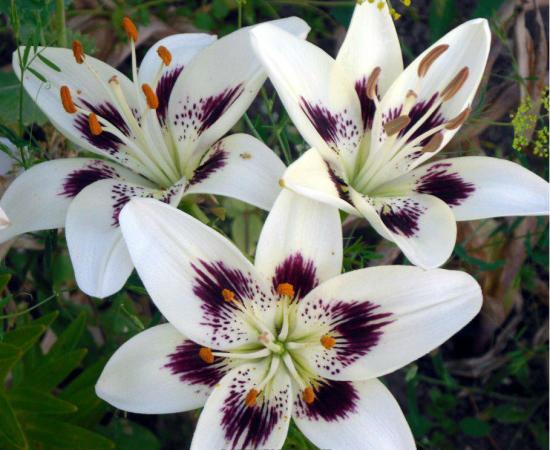
provoke disease The following factors can occur: high soil moisture, excess nitrogen fertilizers. The development of gray rot is indicated by the appearance of dark brown spots on the leaves and stems of the plant. Over time, the spots become pale in the center.
Affected plants are treated using Fundazol, Benomyl, Topsin. If stripes are observed near the veins or pale green spots on the leaves, then this is a clear sign of viral diseases. If the flower is severely affected, it should be dug up and then destroyed to avoid infecting other bulbs.



